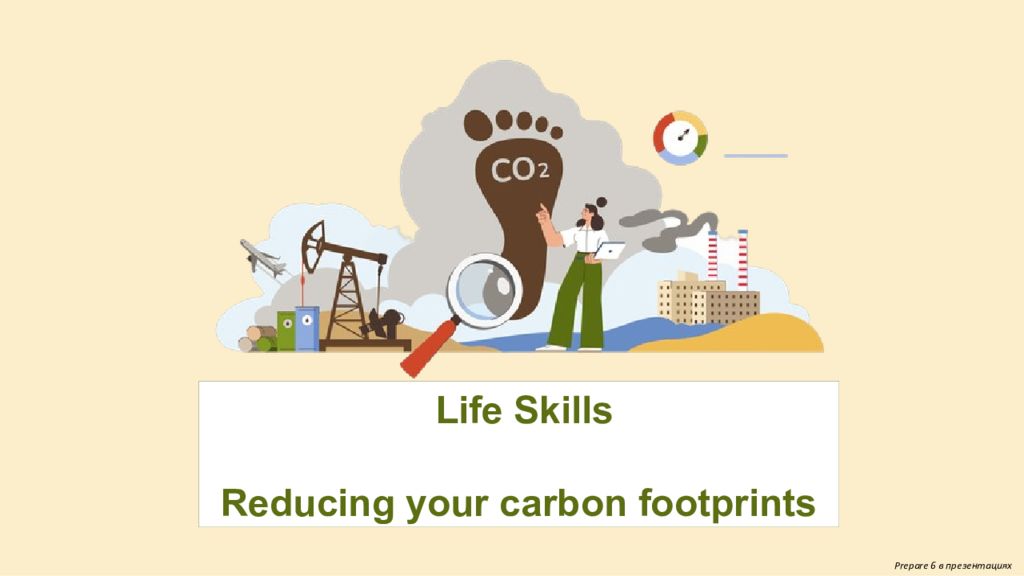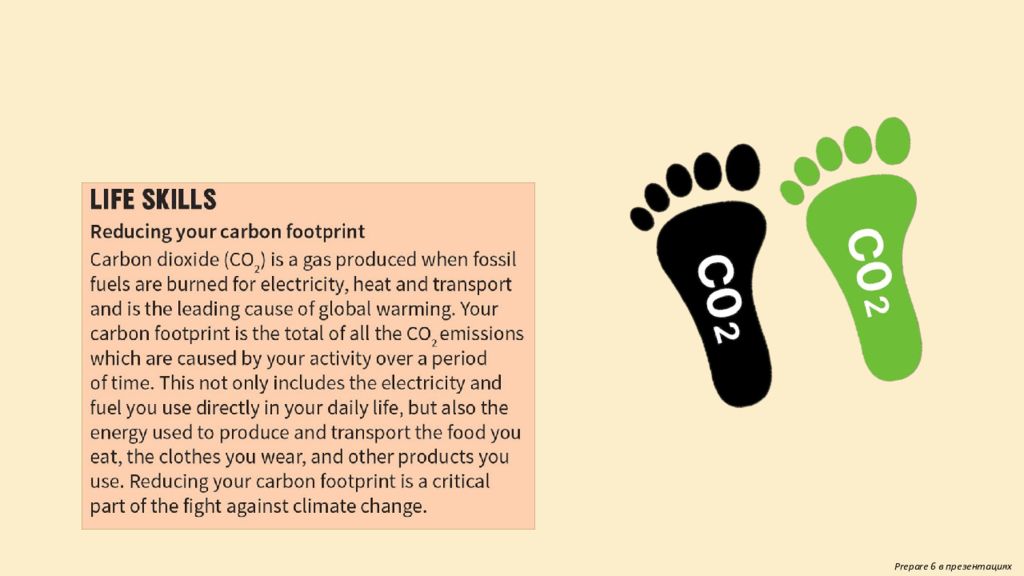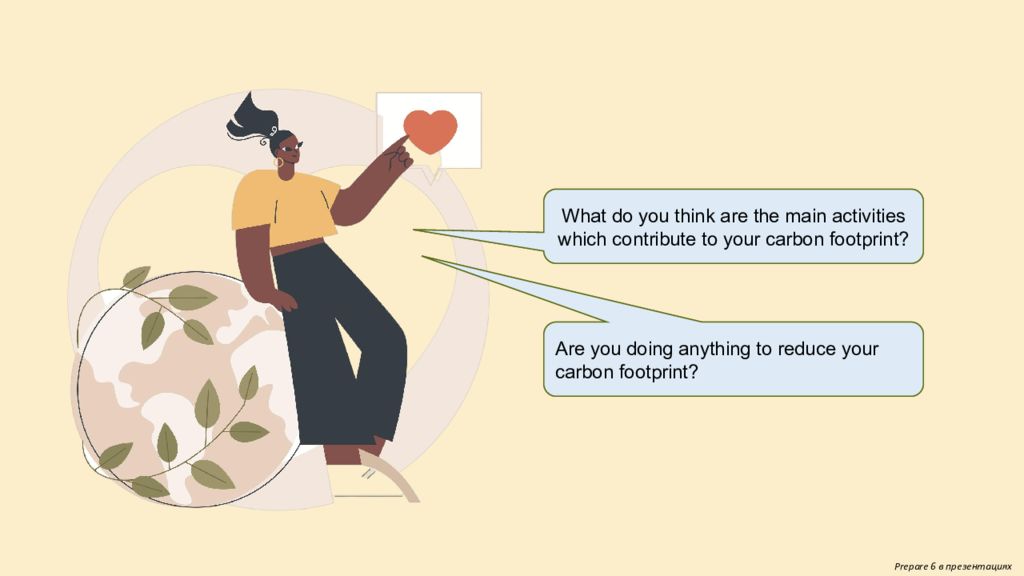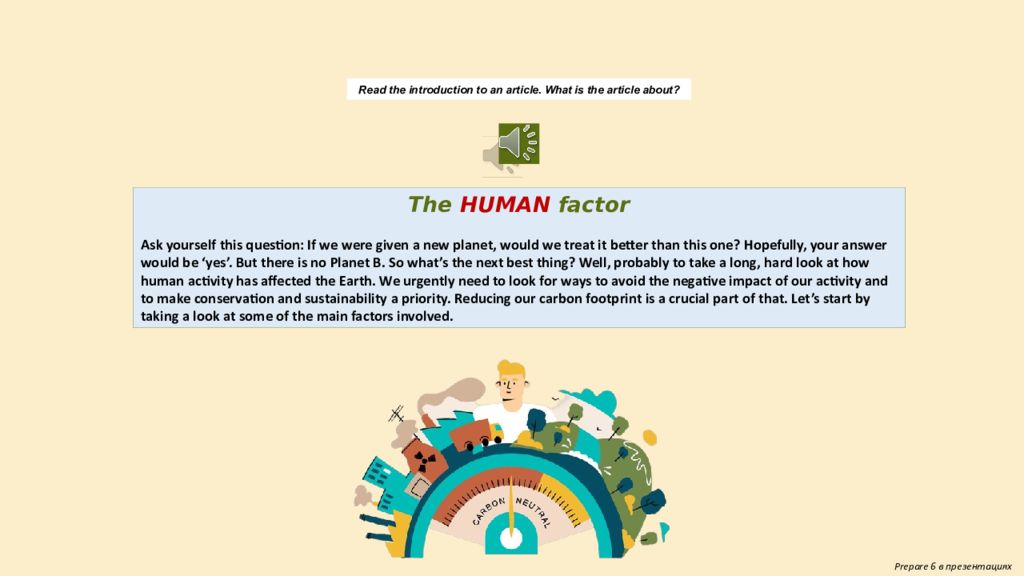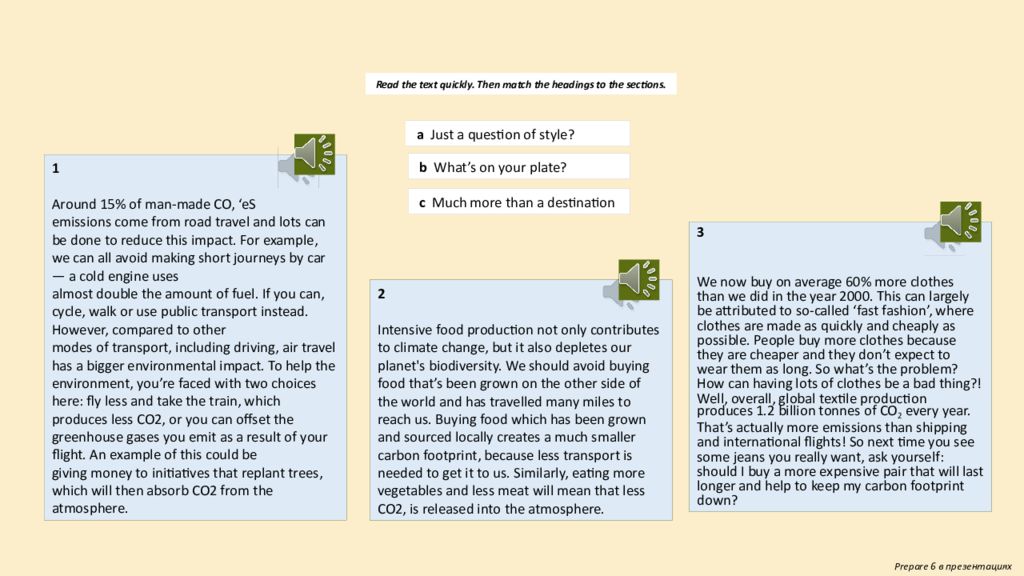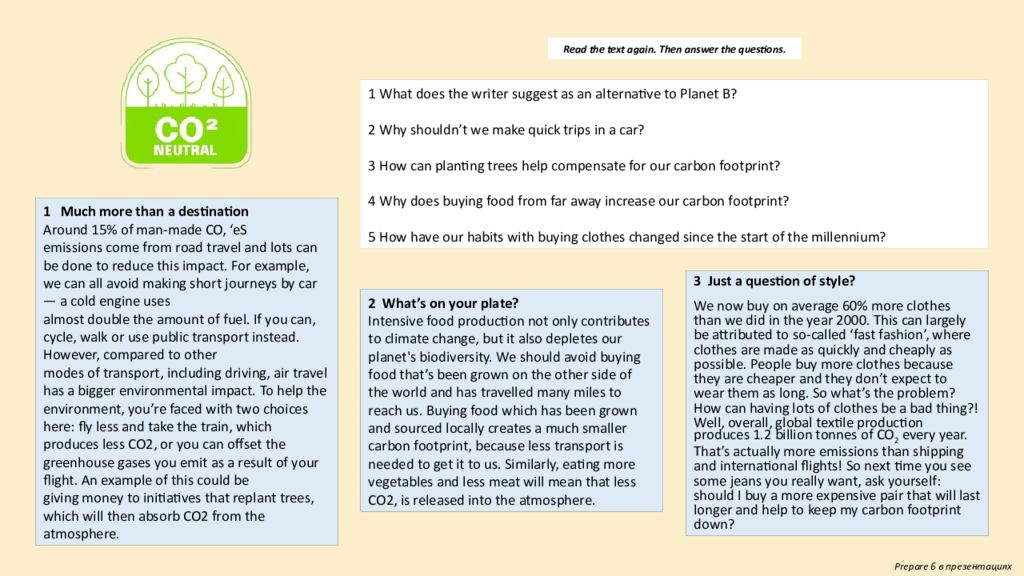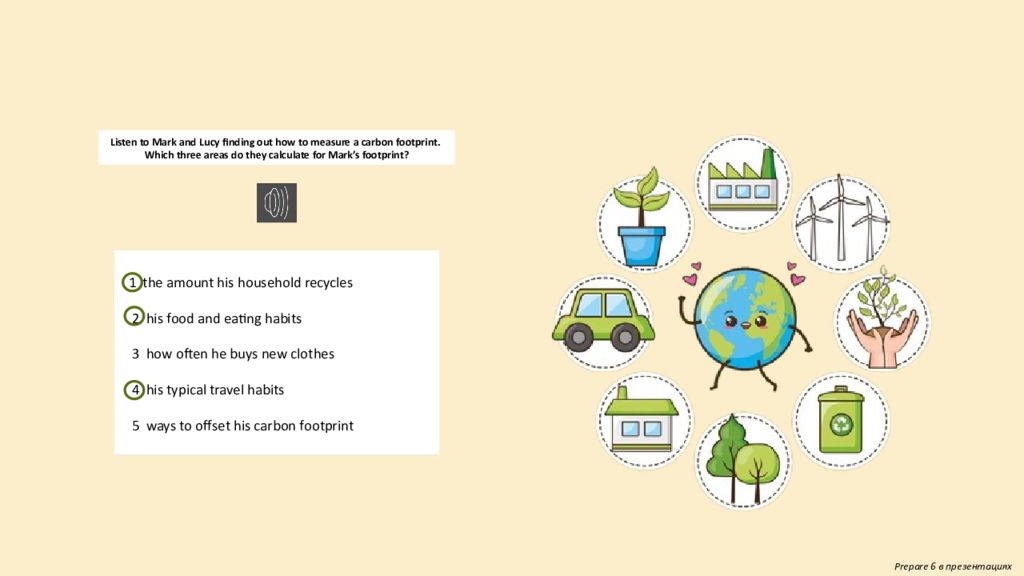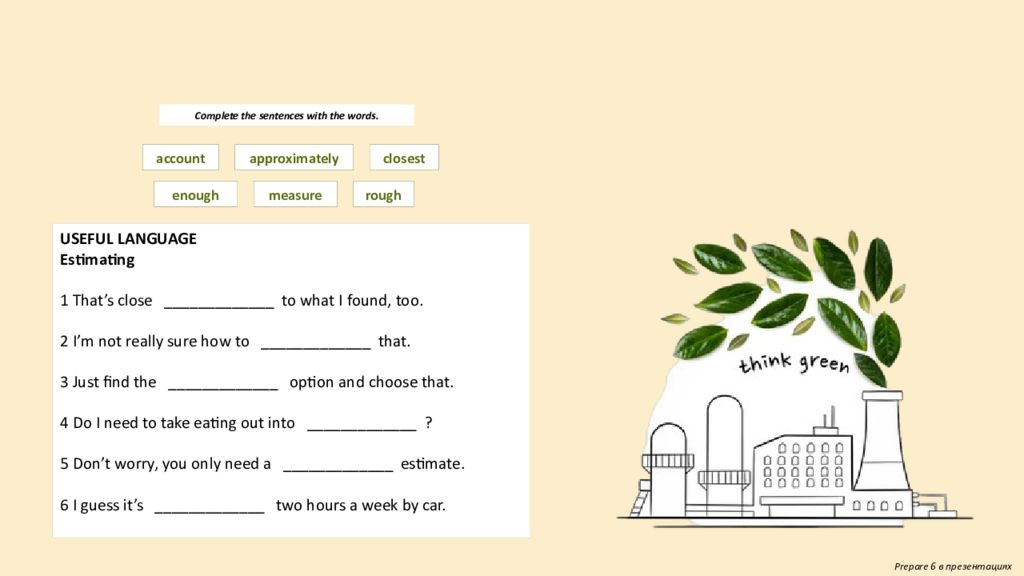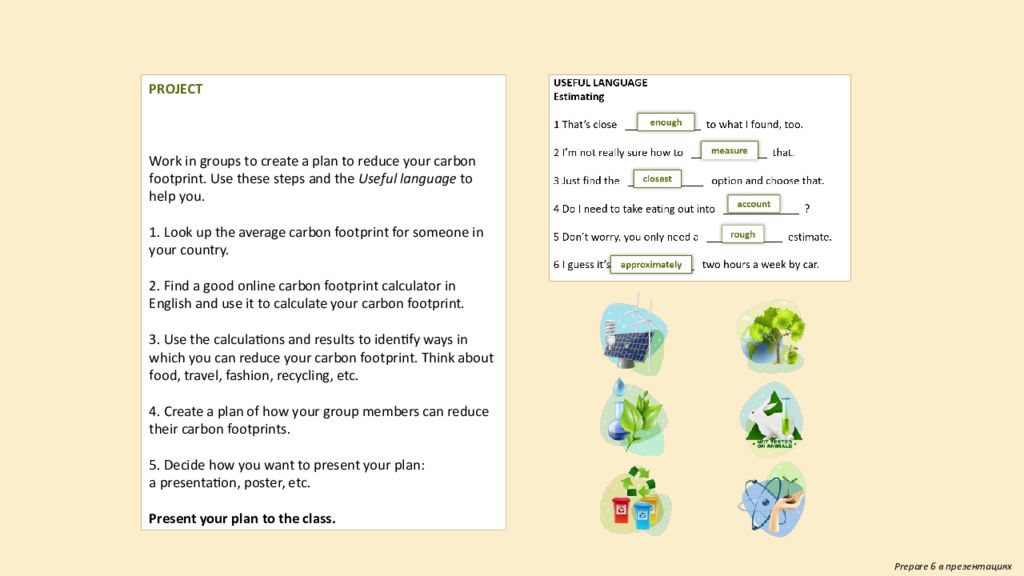Первый слайд презентации
Prepare 6 в презентациях Life Skills Reducing your carbon footprints
Слайд 3
Prepare 6 в презентациях What do you think are the main activities which contribute to your carbon footprint ? Are you doing anything to reduce your carbon footprint ?
Слайд 4
Prepare 6 в презентациях The HUMAN factor Ask yourself this question: If we were given a new planet, would we treat it better than this one? Hopefully, your answer would be ‘yes’. But there is no Planet B. So what’s the next best thing? Well, probably to take a long, hard look at how human activity has affected the Earth. We urgently need to look for ways to avoid the negative impact of our activity and to make conservation and sustainability a priority. Reducing our carbon footprint is a crucial part of that. Let’s start by taking a look at some of the main factors involved. Read the introduction to an article. What is the article about?
Слайд 5
Prepare 6 в презентациях Read the text quickly. Then match the headings to the sections. 3 We now buy on average 60% more clothes than we did in the year 2000. This can largely be attributed to so-called ‘fast fashion’, where clothes are made as quickly and cheaply as possible. People buy more clothes because they are cheaper and they don’t expect to wear them as long. So what’s the problem? How can having lots of clothes be a bad thing?! Well, overall, global textile production produces 1.2 billion tonnes of CO 2 every year. That’s actually more emissions than shipping and international flights! So next time you see some jeans you really want, ask yourself: should I buy a more expensive pair that will last longer and help to keep my carbon footprint down? 2 Intensive food production not only contributes to climate change, but it also depletes our planet's biodiversity. We should avoid buying food that’s been grown on the other side of the world and has travelled many miles to reach us. Buying food which has been grown and sourced locally creates a much smaller carbon footprint, because less transport is needed to get it to us. Similarly, eating more vegetables and less meat will mean that less CO 2, is released into the atmosphere. 1 Around 15% of man-made CO, ‘ eS emissions come from road travel and lots can be done to reduce this impact. For example, we can all avoid making short journeys by car — a cold engine uses almost double the amount of fuel. If you can, cycle, walk or use public transport instead. However, compared to other modes of transport, including driving, air travel has a bigger environmental impact. To help the environment, you’re faced with two choices here : fly less and take the train, which produces less CO 2, or you can offset the greenhouse gases you emit as a result of your flight. An example of this could be giving money to initiatives that replant trees, which will then absorb CO 2 from the atmosphere. a Just a question of style? b What’s on your plate? c Much more than a destination
Слайд 6
Prepare 6 в презентациях 3 Just a question of style? We now buy on average 60% more clothes than we did in the year 2000. This can largely be attributed to so-called ‘fast fashion’, where clothes are made as quickly and cheaply as possible. People buy more clothes because they are cheaper and they don’t expect to wear them as long. So what’s the problem? How can having lots of clothes be a bad thing?! Well, overall, global textile production produces 1.2 billion tonnes of CO 2 every year. That’s actually more emissions than shipping and international flights! So next time you see some jeans you really want, ask yourself: should I buy a more expensive pair that will last longer and help to keep my carbon footprint down? 2 What’s on your plate? Intensive food production not only contributes to climate change, but it also depletes our planet's biodiversity. We should avoid buying food that’s been grown on the other side of the world and has travelled many miles to reach us. Buying food which has been grown and sourced locally creates a much smaller carbon footprint, because less transport is needed to get it to us. Similarly, eating more vegetables and less meat will mean that less CO 2, is released into the atmosphere. 1 Much more than a destination Around 15% of man-made CO, ‘ eS emissions come from road travel and lots can be done to reduce this impact. For example, we can all avoid making short journeys by car — a cold engine uses almost double the amount of fuel. If you can, cycle, walk or use public transport instead. However, compared to other modes of transport, including driving, air travel has a bigger environmental impact. To help the environment, you’re faced with two choices here : fly less and take the train, which produces less CO 2, or you can offset the greenhouse gases you emit as a result of your flight. An example of this could be giving money to initiatives that replant trees, which will then absorb CO 2 from the atmosphere. Read the text again. Then answer the questions. 1 What does the writer suggest as an alternative to Planet B? 2 Why shouldn’t we make quick trips in a car ? 3 How can planting trees help compensate for our carbon footprint ? 4 Why does buying food from far away increase our carbon footprint ? 5 How have our habits with buying clothes changed since the start of the millennium ?
Слайд 7
Prepare 6 в презентациях 2 What’s on your plate? Intensive food production not only contributes to climate change, but it also depletes our planet's biodiversity. We should avoid buying food that’s been grown on the other side of the world and has travelled many miles to reach us. Buying food which has been grown and sourced locally creates a much smaller carbon footprint, because less transport is needed to get it to us. Similarly, eating more vegetables and less meat will mean that less CO 2, is released into the atmosphere. 1 Much more than a destination Around 15% of man-made CO, ‘ eS emissions come from road travel and lots can be done to reduce this impact. For example, we can all avoid making short journeys by car — a cold engine uses almost double the amount of fuel. If you can, cycle, walk or use public transport instead. However, compared to other modes of transport, including driving, air travel has a bigger environmental impact. To help the environment, you’re faced with two choices here : fly less and take the train, which produces less CO 2, or you can offset the greenhouse gases you emit as a result of your flight. An example of this could be giving money to initiatives that replant trees, which will then absorb CO 2 from the atmosphere. Match the highlighted words in the text to the meanings. The HUMAN factor Ask yourself this question: If we were given a new planet, would we treat it better than this one? Hopefully, your answer would be ‘yes’. But there is no Planet B. So what’s the next best thing? Well, probably to take a long, hard look at how human activity has affected the Earth. We urgently need to look for ways to avoid the negative impact of our activity and to make conservation and sustainability a priority. Reducing our carbon footprint is a crucial part of that. Let’s start by taking a look at some of the main factors involved. 1 obtained from a particular place _________________ 2 pay for things that will reduce carbon dioxide in order to reduce the negative effect of your activities _________________ 3 avoiding unnecessary use of natural materials and resources _________________ 4 substances that prevent heat from Earth’s atmosphere escaping into space and cause the planet to become warmer _________________ 5 reduces in size or quantity _________________ sourced conservation offset depletes greenhouse gases
Слайд 8
Prepare 6 в презентациях Listen to Mark and Lucy finding out how to measure a carbon footprint. Which three areas do they calculate for Mark’s footprint? 1 the amount his household recycles 2 his food and eating habits 3 how often he buys new clothes 4 his typical travel habits 5 ways to offset his carbon footprint
Слайд 9
Prepare 6 в презентациях Listen again. Who said these things: Lucy, Mark or both ? 1 On average, a person from the UK has a carbon footprint of approximately 10 tonnes. Lucy / Mark / both 2 Animals in a household aren’t included in the calculations. Lucy / Mark / both 3 Meals eaten in restaurants need to be included. Lucy / Mark / both 4 I travel by car, but not by motorbike. Lucy / Mark / both 5 Mark’s footprint is relatively high compared to international averages. Lucy / Mark / both Mark: Lucy, did you find out the average carbon footprint for someone from the UK? Lucy: Yep, it’s almost 10 tonnes of CO 2. Mark: That’s close enough to what I found, too. The site I was looking at said around 10 to 12 tonnes. Lucy: And did you find a good online calculator? Mark: There were lots, but not all of them were user-friendly! This is the one I chose in the end. Lucy: Great – I was looking at the same one! Let’s make a start on the questions, then. Mark: Sure. Number 1:‘How many people live in your household?’ Lucy: Do pets count? Mark: No, it only says ‘people’! So I’ll put four down for my house. Lucy: Next question: ‘How much of your household waste do you recycle?’ Mark: Hmm. I’m not really sure how to measure that. Lucy: That’s OK. It’s not asking for an exact number. Just find the closest option and choose that. Mark: OK, so ‘most of it’ sounds right to me. Lucy: Perfect. Now, question 3: ‘How often do you eat locally produced food?’ Mark: Do I need to take eating out into account? Lucy: I imagine so. Mark: Well, ‘sometimes’ is probably the best answer. Lucy: OK, next question: How often do you eat meat? Mark: Hmm, that’s difficult to say, really. Lucy: Don’t worry, you only need a rough estimate. Mark: Well, I’d say probably, ‘twice a week’. Lucy: Good. We’re on the last section now: How much do you travel by car or motorbike? Mark: Well, never by motorbike! I guess it’s approximately two hours a week by car. Lucy: And which of the following statements is accurate for you? Mark: Hmm, probably ‘I fly two short-distance flights every year’ … when we go and visit our grandparents. Lucy: So, ready to find out what your carbon footprint is?! Mark: Yep! Well, according to this, my footprint is 9.2 tonnes, so a little less than the average. Lucy: But it’s still high! The average globally is around 5 tonnes. And yours is almost double that! Let’s have a look at the suggestions here here for how to reduce and offset your footprint … Mark: This should be interesting!
Слайд 10
Prepare 6 в презентациях Complete the sentences with the words. USEFUL LANGUAGE Estimating 1 That’s close _____________ to what I found, too. 2 I’m not really sure how to _____________ that. 3 Just find the _____________ option and choose that. 4 Do I need to take eating out into _____________ ? 5 Don’t worry, you only need a _____________ estimate. 6 I guess it’s _____________ two hours a week by car. enough approximately account rough measure closest
Последний слайд презентации: Prepare 6 в презентациях Life Skills Reducing your carbon footprints
Prepare 6 в презентациях PROJECT A plan to reduce your carbon footprints. Work in groups to create a plan to reduce your carbon footprint. Use these steps and the Useful language to help you. 1. Look up the average carbon footprint for someone in your country. 2. Find a good online carbon footprint calculator in English and use it to calculate your carbon footprint. 3. Use the calculations and results to identify ways in which you can reduce your carbon footprint. Think about food, travel, fashion, recycling, etc. 4. Create a plan of how your group members can reduce their carbon footprints. 5. Decide how you want to present your plan: a presentation, poster, etc. Present your plan to the class.
